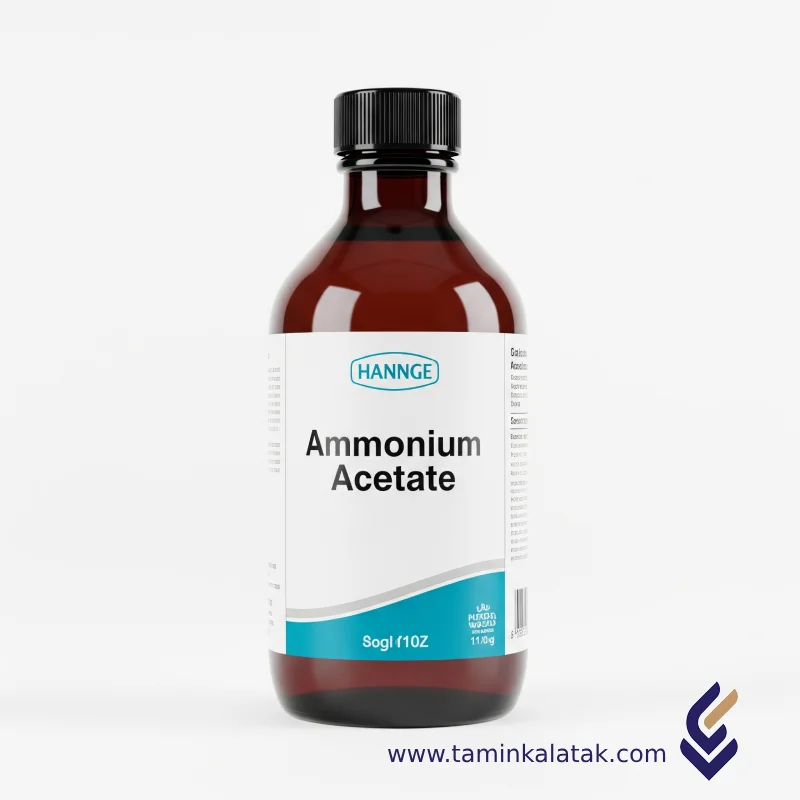Ammonium acetate
Ammonium Acetate, with the chemical formula CH₃COONH₄, is the salt resulting from the reaction between acetic acid and ammonia. It appears as a white crystalline solid, is hygroscopic (moisture-absorbing), and has a faint ammonia odor due to partial decomposition. This compound is derived from a weak acid (acetic acid) and a weak base (ammonia), which gives it buffering properties in aqueous solution.
Structure of Ammonium Acetate
Ammonium acetate is an ionic compound composed of the ammonium cation (NH₄⁺) and the acetate anion (CH₃COO⁻). The acetate ion exhibits resonance between its two oxygen atoms, which contributes to its relative stability.
Chemical formula: CH₃COONH₄
Properties of Ammonium Acetate
-
Appearance: White crystalline powder, transparent or granulated
-
Solubility: Highly soluble in water and ethanol; slightly soluble in acetone
-
Hygroscopic: Easily absorbs moisture from the air
-
Melting Point: ~114 °C; decomposes upon heating into acetic acid and ammonia
-
Density: ~1.07 g/cm³ at 25 °C (equivalent to 1070 kg/m³ in SI units)
-
pH (aqueous solution): Nearly neutral, typically between 6.5 and 7.5 depending on concentration
-
Compressibility: Compressible
-
Colorless: Its solutions are usually clear and colorless
Applications of Ammonium Acetate
Food Industry:
-
Used as a food additive (E264)
-
Functions as a buffer and preservative in certain food products
Laboratory and Research:
-
pH buffer: Used in biochemistry, analytical chemistry, and molecular biology to maintain stable pH in reactions and enzyme processes (e.g., DNA extraction and protein purification)
-
Chromatography: Serves as a buffer or mobile phase in HPLC and mass spectrometry due to its volatility
-
Microbial detection
-
Biological media: Occasionally used in specialized bacterial growth environments
Pharmaceutical Industry:
-
Used in the manufacture of certain drugs and injectable solutions
-
Applied in organic synthesis of pharmaceutical compounds
Textile Industry:
-
Functions as an auxiliary agent in textile printing and dyeing processes
Chemical Industry:
-
Serves as a source of acetate or ammonia ions in organic synthesis
-
Used in the production of certain plastics and resins
-
Acts as a corrosion inhibitor in specific processes
Wastewater Treatment:
-
Used in biological processes to supply carbon and nitrogen for bacteria
Environmental Applications:
-
Used in some airport de-icing compounds as a chloride-free alternative
Advantages of Ammonium Acetate
-
Strong buffering capacity: Regulates and maintains pH near neutral
-
Volatile: Leaves no residue after evaporation, ideal for HPLC and mass spectrometry
-
Biodegradable: Breaks down naturally in the environment
-
High water solubility: Allows for preparation of high-concentration aqueous solutions
-
Relatively safe: Low toxicity in lab and industrial settings
-
Versatile use: Broadly applied across food, pharmaceutical, and chemical industries
Disadvantages of Ammonium Acetate
-
Ammonia odor: Releases a pungent, mild ammonia smell upon decomposition
-
Hygroscopicity: Absorbs moisture rapidly, requiring moisture-resistant packaging
-
Thermal decomposition: Breaks down into ammonia and acetic acid at high temperatures
-
Potential irritation:
-
Eye contact: May cause irritation, redness, or burning
-
Skin contact: May cause mild irritation
-
Inhalation of dust: May cause coughing or shortness of breath
-
Ingestion: In large amounts, may lead to gastrointestinal discomfort
-
-
Ventilation required: Especially in enclosed areas, due to irritating vapors
Applications
| Applications | , , , , |
|---|
Ammonium acetate
| Chemical name (IUPAC) | Molecular formula | Molecular mass | Physical appearance | Density (at 20°C) | Melting point | Solubility in water (20°C) | pH of 5% solution in water | Main applications |
|---|---|---|---|---|---|---|---|---|
| Ammonium ethanoate | CH₃COONH₄ | 77.08 g/mol | White, crystalline or granular powder | 1.17 g/cm³ | 114–116°C (decomposes at higher temperatures) | Completely soluble (~1480 g/L) | About 7.0 (neutral to slightly acidic) | Buffer in chromatography and biology, chemical synthesis, pharmaceutical additive, agriculture |







